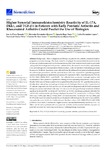Higher synovial immunohistochemistry reactivity of IL-17A, Dkk1, and TGF-β1 in patients with early psoriatic arthritis and rheumatoid arthritis could predict the use of biologics

Ver/Abrir
Use este enlace para citar
http://hdl.handle.net/2183/36463
Excepto si se señala otra cosa, la licencia del ítem se describe como Creative Commons Attribution 4.0 International License (CC-BY 4.0)
Colecciones
- Investigación (FCS) [1295]
Metadatos
Mostrar el registro completo del ítemTítulo
Higher synovial immunohistochemistry reactivity of IL-17A, Dkk1, and TGF-β1 in patients with early psoriatic arthritis and rheumatoid arthritis could predict the use of biologicsAutor(es)
Fecha
2024-04-08Cita bibliográfica
Pinto-Tasende JA, Fernandez-Moreno M, Rego Perez I, Fernandez-Lopez JC, Oreiro-Villar N, De Toro Santos FJ, Blanco-García FJ. Higher synovial immunohistochemistry reactivity of IL-17A, Dkk1, and TGF-β1 in patients with early psoriatic arthritis and rheumatoid arthritis could predict the use of biologics . Biomedicines. 2024 Apr 8;12(4):815.
Resumen
[Abstract] Background: Delay in diagnosis and therapy in patients with arthritis commonly leads to progressive articular damage. The study aimed to investigate the immunohistochemical reactivity of synovial cytokines associated with inflammation and the bone erosives/neoformatives processes among individuals diagnosed with psoriatic arthritis (PsA), rheumatoid arthritis (RA), osteoarthritis (OA), and radiographic axial spondyloarthritis (r-axSpA), with the intention of identifying potential biomarkers. Methods: Specimens were collected from the inflamed knee joints of patients referred for arthroscopic procedures, and the synovial tissue (ST) was prepared for quantifying protein expression through immunohistochemical analysis (% expressed in Ratio_Area-Intensity) for TGF-β1, IL-17A, Dkk1, BMP2, BMP4, and Wnt5b. The collected data underwent thorough analysis and examination of their predictive capabilities utilising receiver operating characteristic (ROC) curves. Results: Valid synovial tissue samples were acquired from 40 patients for IHC quantification analysis. Initially, these patients had not undergone treatment with biologics. However, after 5 years, 4 out of 13 patients diagnosed with PsA and two out of nine patients diagnosed with RA had commenced biologic treatments. Individuals with early PsA who received subsequent biologic treatment exhibited significantly elevated IHC reactivity in ST for TGF-β1 (p = 0.015). Additionally, patients with both PsA and RA who underwent biologic therapy displayed increased IHC reactivity for IL-17A (p = 0.016), TGF-β1 (p = 0.009), and Dkk1 (p = 0.042). ROC curve analysis of IHC reactivity for TGF-β1, Dkk1, and IL-17A in the synovial seems to predict future treatment with biologics in the next 5 years with the area under the curve (AUC) of a combined sum of the three values: AUC: 0.828 (95% CI: 0.689–0.968; p 0.005) S 75% E 84.4%. Conclusions: Higher synovial immunohistochemistry reactivity of IL-17A, Dkk1, and TGF-β1 in patients with early psoriatic arthritis and rheumatoid arthritis may serve as potential indicators for predicting the necessity of utilising biologic treatments.
Palabras clave
IL-17A
TGF-β1
Dkk1
IHC reactivity
Psoriatic arthritis
Synovial tissue
Biomarker
TGF-β1
Dkk1
IHC reactivity
Psoriatic arthritis
Synovial tissue
Biomarker
Versión del editor
Derechos
Creative Commons Attribution 4.0 International License (CC-BY 4.0)
ISSN
2227-9059






